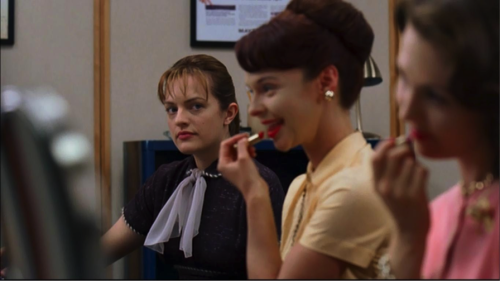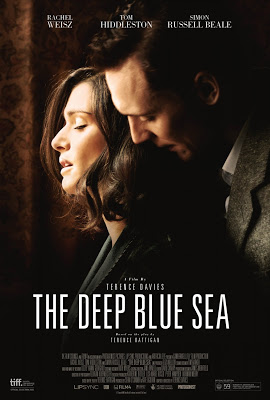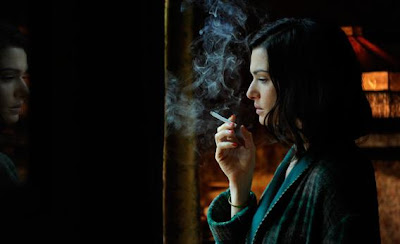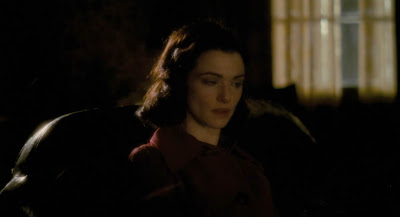This guest post by Caroline Madden appears as part of our theme week on The Female Gaze.
Mad Men is a remarkable portrayal of the 1960s that explores the office and home lives of workers in the New York City advertising industry over the course of a decade. The 60s was a particularly patriarchal and sexist period of history, as was the profession that Mad Men depicts. Advertising, even for women’s products, was driven by the male gaze. Mad Men aims to portray the decade and the world of Madison Avenue advertising as accurately as possible, but does not view it from the patriarchal standpoint of the time.
In the Establishing Mad Men documentary, creator Matthew Weiner states that Mad Men “is about conflicting desires in the American male, and the people who pay the price for that are women.” The leading women in the series who pay that price are Peggy Olson, Joan Harris, and Betty Draper. The struggles of Mad Men’s male characters have ramifications on them. Weiner uses the female gaze of these women to criticize the sexism of the era and profession they inhabit, while rendering fully realized and dynamic female characters. Peggy, Joan, and Betty are depicted as sexual, complicated, and diverse human beings.
In the first season of Mad Men especially, much of the dialogue shows the vast amount of overt sexism in the workplace. The Sterling Cooper secretaries are a smorgasbord available for men’s consumption, objects they can use for their amusement or lust. For most audience members of the 2000s, this blatant sexism is baffling, and some may find it oddly humorous just how much was acceptable or tolerated back then.
We experience this sexism through the eyes and gaze of Peggy Olson, who, much like the audience, is being introduced to the world of Sterling Cooper in the first episode. Peggy ends up being the female character most tied with the nature of advertising- making her way from Don Draper’s secretary to copywriter and then copy chief. But at first she is just another secretary, a new piece of fresh meat for the men. Peggy has never worked in an office before; she is straight out of secretarial school. Raised in a strict Catholic family, Peggy has likely never experienced male ogling at quite this level. By Episode 2, “Ladies’ Room,” Peggy is already fed up: “Honestly, why is it that every time a man takes you out to lunch around here, you’re…you’re the dessert!” she bemoans to Joan. Matthew Weiner uses the female gaze purposefully in the following scene where the camera allows the audience to identify with Peggy as the men’s prey. As Peggy sits at her desk on the typewriter, the camera cuts to many different men in slow-motion gazing at her, with reverse low angle-shots of Peggy. The multiple and unrelenting gazes of men echoes Peggy’s dialogue from minutes before: “It’s constant from every corner.” The low-angle on Peggy heightens her overwhelming feeling of their gaze.
Peggy’s role puts her in the position of seeing not only the advertising world firsthand, but also the male point of view that it so actively employs, and from her first account, she begins to challenge that point of view. Peggy’s rise in advertising begins with a Belle Jolie lipstick campaign. The Sterling Cooper secretaries are treated to a testing session (viewed by the men behind a two-way mirror) where they can try on as many Belle Jolie lipsticks as they please. The gaggle of secretaries are thrilled, but Peggy sits there unhappily. The camera shows Peggy watching the girls try on lipsticks in slow motion, the seeds of her first copy pitch planting in her brain. Freddy Rumsen asks Peggy why she didn’t try on any lipsticks. Peggy tells him that they didn’t have her color, that she is very particular: “I don’t think anyone wants to be one of a hundred colors in a box.” The men are failing to see the individuality in women, and instead choosing to see them as a limited whole. Peggy’s observations leads her to be promoted to copywriter for that campaign.
In Season 3, Peggy continues to challenge the male gaze in advertising. In a campaign for Patio, the clients want a shot-for-shot reenactment Bye Bye Birdie’s opening: “She’s throwing herself at the camera. No one seems to care that it speaks to men. Not the people that drink diet drinks.” Peggy asks Don about the faux Ann-Margaret. “It’s not about making women feel fat. It’s ‘look how happy I am drinking Patio. I’m young and excited and desperate for a man,’” Don replies. “I don’t mind fantasies, but shouldn’t it be a female one?” Peggy asks. “Peggy, you understand how this works: men want her, women want to be her.” Don is subtly insisting to Peggy that advertising, even for women’s products, is aimed for men. Don is also hinting to Peggy that if she keeps up the criticisms about the male gaze in advertising, she will lose her job.
Another example is the Playtex ad from Season 2 Episode 6’s “Maidenform.” Kinsey comes up with an idea that every woman is either a Jackie or Marilyn. He points to various women in the office pinpointing which one they are. “I don’t know if all women are a Jackie or a Marilyn. Maybe men seem them that way,” Peggy counters. “Bras are for men. Women want to see themselves the way men see them,” Kinsey insists.
As the series progresses into the mid-60s, we see the gradual shift into (slightly) more open-minded ideals about the roles of women in the workplace. Peggy is promoted and works on many campaigns. In fact, many of the clients grow to appreciate the benefit of the female gaze, making their products truly (for the most part) appealing to women. This makes more profit than the false patriarchal ideas of a woman’s wants and needs. With the character of Peggy, Weiner is able to let us see the advertising world from the female gaze to criticize the falsehood that lies in selling female products with a male gaze.
Peggy makes the biggest change as the series goes on, from a meek, mousy girl to a headstrong woman, though her evolution is no surprise upon reflection. Outside of the office, Peggy is seen many times exerting control over her own sexuality and choice of sexual partners. Peggy’s struggles of putting career over having a family are honestly and sensitively executed by Weiner.
Another female character tied to Sterling Cooper is Joan Holloway (later Harris). No other character experiences the male gaze as much as Joan. In the beginning seasons, the camera flatters and accentuates every curve of Hendricks’s voluptuous body. We see her as the men in the office see her. But one scene turns this on its head, in Season 1’s “Babylon,” at the Belle Jolie lipstick testing. Joan oversees the secretaries wearing a gorgeous skin-tight red dress. The camera views Joan (as the men view her) as she walks across the table, slyly looking at the two-way mirror. The camera then glides over to and fixes on Joan’s bottom as she bends over. Cut to Joan smirking, turning around and looking squarely at the mirror, almost straight into the camera. Joan knows the men are gazing at her, and she takes possession of that gaze by giving them what they want to see. The men think they have the power in being able to gaze at her unknowingly, but the power lies in Joan’s hands as she presents herself to be looked at. When Joan looks into the camera, it is almost as if she is also challenging the audience as well.
The character of Joan is frequently seen as a sexual object by all those around her. Many of her storylines revolve around the harmful ramifications you experience when you are only viewed by how you look and your body. The men around her, and even Joan herself, tend to use that sexuality as a pawn. Joan knows she exactly how she is viewed and objectified by the men in the office, and she yields that power for better or for worse. Two significant plot points happen to Joan–the rape by her fiancé and the act of prostitution to obtain the Jaguar account and a higher position in the office. As she lies on the office floor with Greg on top of her, or as awful, the awful car salesman kisses her and takes off her fur coat, the camera fixes on only Joan in a close-up. By doing that we are able to empathize with only her instead of focusing on the act. Weiner visually does not reduce these scenes to moments of exploitation. We are not centered on the event itself, but on what Joan is going through.
The show itself does not reduce Joan to just a sexual object as much as the men around her would like her to be so. Joan is a very smart, capable woman that is excellent at her job, more so than some of the men are. She often goes unappreciated until she does obtain her higher-up position. The show’s finale shows Joan running a production company in her home while raising her son.
Outside of Sterling Cooper, but connected to leading man Don Draper, is Betty Draper (later Francis). Betty’s image is one of passive, docile sexuality and complete perfection. Throughout the series, we quickly learn that there is more beneath Betty’s Barbie Doll-esque façade, for Weiner delves deeper than the false image she presents. Betty’s character seems ripped straight out the pages of Betty Friedan’s The Feminine Mystique, a visual personification of “the problem that has no name” that she studied in housewives. Betty’s character allows viewers of modern day to see the nature of those housewives’ lives; there are multiple scenes of the dull drudgery and loneliness Betty deals with day to day alone in the house.
We first get a glimpse at her underlying sexuality when she tells Don, “I want you so much. I thought about it all day. No I mean it. It’s all I think about…every day. Your car coming down the driveway. I put the kids to bed early. I make a grocery list. I cook butterscotch pudding. I never let my hands idle. Brushing my hair, drinking my milk…and it’s all in kind of a fog because I can’t stop thinking about this. I want you so badly.” From this we learn that Betty is very much at the whim of Don’s actions. One episode delves further into Betty’s brimming sexuality, when we see her pleasuring herself against a washing machine while fantasizing about making love to the air conditioner salesman. In Season 3, after seeing Don sleep with so many other women, there is a scene of Betty controlling her sexuality when she sleeps with a stranger from a bar. Matthew Weiner takes great care in telling her side of the story in the marriage and relation to Don. Betty is not shown to be the demure or child-like woman that Don or others may view her as.
Mad Men is one of the few shows that depicts a successful representation of the female gaze, despite taking place in an era and profession where female’s experiences were often devalued. Weiner does not reduce the women to just mere symbols of the decade’s movements but crafts them as complicated and dynamic human beings living in an equally complicated time. And this is not limited to just Peggy, Joan, and Betty. Mad Men has many women, good qualities and bad, older women, mothers, grandmothers, young girls, teenagers, within the show that Weiner manages–even through small parts–to finely craft. Weiner uses the female gaze as one of many ways to examine the fascinating decade.
Caroline Madden has a BFA in Acting from Shenandoah Conservatory and is working on an MA in Cinema Studies at Savannah College of Art and Design. She writes about film at Geek Juice, Screenqueens, and her blog. You can usually find her watching movies or listening to Bruce Springsteen.









